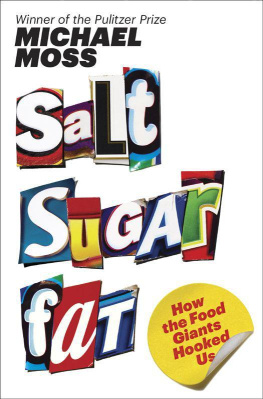Michael Moss - Salt Sugar Fat: How the Food Giants Hooked Us
Here you can read online Michael Moss - Salt Sugar Fat: How the Food Giants Hooked Us full text of the book (entire story) in english for free. Download pdf and epub, get meaning, cover and reviews about this ebook. year: 2013, publisher: The Random House Publishing Group, genre: Romance novel. Description of the work, (preface) as well as reviews are available. Best literature library LitArk.com created for fans of good reading and offers a wide selection of genres:
Romance novel
Science fiction
Adventure
Detective
Science
History
Home and family
Prose
Art
Politics
Computer
Non-fiction
Religion
Business
Children
Humor
Choose a favorite category and find really read worthwhile books. Enjoy immersion in the world of imagination, feel the emotions of the characters or learn something new for yourself, make an fascinating discovery.
- Book:Salt Sugar Fat: How the Food Giants Hooked Us
- Author:
- Publisher:The Random House Publishing Group
- Genre:
- Year:2013
- Rating:5 / 5
- Favourites:Add to favourites
- Your mark:
- 100
- 1
- 2
- 3
- 4
- 5
Salt Sugar Fat: How the Food Giants Hooked Us: summary, description and annotation
We offer to read an annotation, description, summary or preface (depends on what the author of the book "Salt Sugar Fat: How the Food Giants Hooked Us" wrote himself). If you haven't found the necessary information about the book — write in the comments, we will try to find it.
Salt Sugar Fat: How the Food Giants Hooked Us — read online for free the complete book (whole text) full work
Below is the text of the book, divided by pages. System saving the place of the last page read, allows you to conveniently read the book "Salt Sugar Fat: How the Food Giants Hooked Us" online for free, without having to search again every time where you left off. Put a bookmark, and you can go to the page where you finished reading at any time.
Font size:
Interval:
Bookmark:

Copyright 2013 by Michael Moss
All rights reserved.
Published in the United States by Random House, an imprint of The Random House Publishing Group, a division of Random House, Inc., New York.
RANDOM HOUSE and colophon are registered trademarks of Random House, Inc.
Library of Congress Cataloging-in-Publication Data
Moss, Michael.
Salt, sugar, fat : how the food giants hooked us / Michael Moss.
p. cm.
eISBN: 978-0-679-60477-8
1. NutritionEconomic aspectsUnited States. 2. Food habitsEconomic aspectsUnited States. 3. Food industry and tradeUnited States. I. Title.
RA784.M638 2013
613.2dc23 2012033034
www.atrandom.com
Cover design: Anton Ioukhnovets
v3.1
contentsprologue
The Company Jewels
Minneapolis was having a blustery spring evening on April 8, 1999, when a long line of town cars and taxis pulled up to the office complex on South 6th Street and discharged their well-dressed passengers. These eleven men were the heads of Americas largest food companies. Among them, they controlled seven hundred thousand employees and $280 billion in annual sales. And even before their sumptuous dinner was served, they would be charting a course for their industry for years to come.
There would be no reporters at this gathering. No minutes taken, no recordings made. Rivals any other day, the CEOs and company presidents had come together for a meeting that was as secretive as it was rare. On the agenda was one item: the emerging epidemic of obesity and how to deal with it.
Pillsbury was playing host at its corporate headquarters, two glass and steel towers perched on the eastern edge of downtown. The largest falls on the Mississippi River rumbled a few blocks away, near the historic brick and iron-roller mills that, generations before, had made this city the flour-grinding capital of the world. A noisy midwestern wind gusting to 45 miles an hour buffeted the towers as the executives boarded the elevators and made their way to the thirty-first floor.
A top official at Pillsbury, fifty-five-year-old James Behnke, greeted the men as they walked in. He was anxious but also confident about the plan that he and a few other food company executives had devised to engage the CEOs on Americas growing weight problem. We were very concerned, and rightfully so, that obesity was becoming a major issue, Behnke recalled. People were starting to talk about sugar taxes, and there was a lot of pressure on food companies. As the executives took their seats, Behnke particularly worried about how they would respond to the evenings most delicate matter: the notion that they and their companies had played a central role in creating this health crisis. Getting the company chiefs in the same room to talk about anything, much less a sensitive issue like this, was a tricky business, so Behnke and his fellow organizers had scripted the meeting carefully, crafting a seating chart and honing the message to its barest essentials. CEOs in the food industry are typically not technical guys, and theyre uncomfortable going to meetings where technical people talk in technical terms about technical things, Behnke said. They dont want to be embarrassed. They dont want to make commitments. They want to maintain their aloofness and autonomy.
Nestl was in attendance, as were Kraft and Nabisco, General Mills and Procter & Gamble, Coca-Cola and Mars. The companies present were the dominant players in processed industrial food, fiercely aggressive competitors who, when not gathering in secret, were looking to bludgeon one another in the grocery store.
Just that year, the head of General Mills had muscled his company past Kellogg to become the countrys largest cereal maker, hooking shoppers with a dazzling lineup of new products and flavors, sold at reduced prices to boost sales all the more. General Mills was dominating in the dairy aisle as well, showing the rest of the industry just how easy it was to influence Americas eating habits. The companys Yoplait brand had already transformed traditional unsweetened breakfast yogurt into a dessert-like snack. It now had twice as much sugar per serving as Lucky Charms, the companys cloyingly sweet, marshmallow-filled cereal. And yet, because of yogurts well-tended image as a wholesome, life-giving snack, sales of Yoplait were soaring, with annual revenue topping $500 million. Emboldened by the success, General Mills development wing pushed even harder, inventing a yogurt that came in a squeezable tubeperfect for kidseliminating the need for a spoon. They called it Go-Gurt, and rolled it out nationally in the weeks before the CEO meeting. (By years end, it would hit $100 million in sales.)
So while the atmosphere at the meeting was cordial, the CEOs were hardly friends. Their stature was defined by their skill in fighting each other for what they called stomach share, or the amount of digestive space that any one companys brand can grab from the competition. If they eyed one another suspiciously that evening, it was for good reason. By 2001, Pillsburys chief would be gone and the 127-year-old companywith its cookies, biscuits, and toaster strudelwould be acquired by General Mills.
Two of the men at the meeting rose above the fray. They were here to represent the industry titans, Cargill and Tate & Lyle, whose role it was to supply the CEOs with the ingredients they relied on to win. These were no run-of-the-mill ingredients, either. These were the three pillars of processed food, the creators of crave, and each of the CEOs needed them in huge quantities to turn their products into hits. These were also the ingredients that, more than any other, were directly responsible for the obesity epidemic. Together, the two suppliers had the salt, which was processed in dozens of ways to maximize the jolt that taste buds would feel with the very first bite; they had the fats, which delivered the biggest loads of calories and worked more subtly in inducing people to overeat; and they had the sugar, whose raw power in exciting the brain made it perhaps the most formidable ingredient of all, dictating the formulations of products from one side of the grocery store to the other.
James Behnke was all too familiar with the power of salt, sugar, and fat, having spent twenty-six years at Pillsbury under six chief executive officers. A chemist by training with a doctoral degree in food science, he became the companys chief technical officer in 1979 and was instrumental in creating a long line of hit products, including microwavable popcorn. He deeply admired Pillsbury, its employees, and the warm image of its brand. But in recent years, he had seen the endearing, innocent image of the Pillsbury Doughboy replaced by news pictures of children too obese to play, suffering from diabetes and the earliest signs of hypertension and heart disease. He didnt blame himself for creating high-calorie foods that the public found irresistible. He and other food scientists took comfort in knowing that the grocery store icons they had invented in a more innocent erathe soda and chips and TV dinnershad been imagined as occasional fare. It was society that had changed, changed so dramatically that these snacks and convenience foods had become a dailyeven hourlyhabit, a staple of the American diet.
Behnkes perspective on his lifes work, though, began to shift when he was made a special advisor to Pillsburys chief executive in 1999. From his new perch, Behnke started to get a different view of what he called the big tenets of his industrytaste, convenience, and cost. He worried, especially, about the economics that drive companies to spend as little money as possible in making processed foods. Cost was always there, he told me. Companies had different names for it. Sometimes they were called PIPs, or profit improvement programs, or margin enhancements, or cost reduction. Whatever you want to call it, people are always looking for a less expensive way.
Next pageFont size:
Interval:
Bookmark:
Similar books «Salt Sugar Fat: How the Food Giants Hooked Us»
Look at similar books to Salt Sugar Fat: How the Food Giants Hooked Us. We have selected literature similar in name and meaning in the hope of providing readers with more options to find new, interesting, not yet read works.
Discussion, reviews of the book Salt Sugar Fat: How the Food Giants Hooked Us and just readers' own opinions. Leave your comments, write what you think about the work, its meaning or the main characters. Specify what exactly you liked and what you didn't like, and why you think so.






